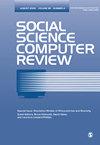揭开隐性威胁的面纱:机器人对 COVID-19 健康传播的影响
IF 2.7
2区 社会学
Q2 COMPUTER SCIENCE, INTERDISCIPLINARY APPLICATIONS
引用次数: 0
摘要
本文介绍了一项综合研究的结果,该研究考察了三年来机器人对推特上传播 COVID-19 错误信息和负面疫苗立场的影响。研究采用了三方方法:文本分类、主题建模和网络分析来探讨这一现象。文本分类利用图尔库大学 FinBERT 预训练嵌入模型,区分了错误信息和疫苗立场检测。使用 Botometer 软件识别了类似机器人的 Twitter 账户,并通过进一步分析将 COVID-19 特定机器人账户与普通机器人账户区分开来。网络分析揭示了 COVID-19 机器人在转发和提及网络中的传播模式。研究结果表明,这些机器人表现出了与众不同的特征和策略,使其能够影响公众言论,尤其是在与 COVID-19 相关的对话中表现出更高的活跃度。主题建模分析发现,COVID-19 机器人主要关注安全、政治/阴谋论和个人选择等主题。这项研究强调了制定有效策略来检测和对抗僵尸影响的迫切需要。基本行动包括在健康传播中使用简洁明了的语言,在危机期间建立战略合作伙伴关系,以及确保数字平台上用户账户的真实性。研究结果强调了机器人在传播与 COVID-19 和疫苗有关的错误信息中的关键作用,突出了识别和减少机器人活动以进行有效干预的必要性。本文章由计算机程序翻译,如有差异,请以英文原文为准。
Unveiling the Veiled Threat: The Impact of Bots on COVID-19 Health Communication
This article presents the results of a comprehensive study examining the influence of bots on the dissemination of COVID-19 misinformation and negative vaccine stance on Twitter over a period of three years. The research employed a tripartite methodology: text classification, topic modeling, and network analysis to explore this phenomenon. Text classification, leveraging the Turku University FinBERT pre-trained embeddings model, differentiated between misinformation and vaccine stance detection. Bot-like Twitter accounts were identified using the Botometer software, and further analysis was implemented to distinguish COVID-19 specific bot accounts from regular bots. Network analysis illuminated the communication patterns of COVID-19 bots within retweet and mention networks. The findings reveal that these bots exhibit distinct characteristics and tactics that enable them to influence public discourse, particularly showing an increased activity in COVID-19-related conversations. Topic modeling analysis uncovers that COVID-19 bots predominantly focused on themes such as safety, political/conspiracy theories, and personal choice. The study highlights the critical need to develop effective strategies for detecting and countering bot influence. Essential actions include using clear and concise language in health communications, establishing strategic partnerships during crises, and ensuring the authenticity of user accounts on digital platforms. The findings underscore the pivotal role of bots in propagating misinformation related to COVID-19 and vaccines, highlighting the necessity of identifying and mitigating bot activities for effective intervention.
求助全文
通过发布文献求助,成功后即可免费获取论文全文。
去求助
来源期刊

Social Science Computer Review
社会科学-计算机:跨学科应用
CiteScore
9.00
自引率
4.90%
发文量
95
审稿时长
>12 weeks
期刊介绍:
Unique Scope Social Science Computer Review is an interdisciplinary journal covering social science instructional and research applications of computing, as well as societal impacts of informational technology. Topics included: artificial intelligence, business, computational social science theory, computer-assisted survey research, computer-based qualitative analysis, computer simulation, economic modeling, electronic modeling, electronic publishing, geographic information systems, instrumentation and research tools, public administration, social impacts of computing and telecommunications, software evaluation, world-wide web resources for social scientists. Interdisciplinary Nature Because the Uses and impacts of computing are interdisciplinary, so is Social Science Computer Review. The journal is of direct relevance to scholars and scientists in a wide variety of disciplines. In its pages you''ll find work in the following areas: sociology, anthropology, political science, economics, psychology, computer literacy, computer applications, and methodology.
 求助内容:
求助内容: 应助结果提醒方式:
应助结果提醒方式:


